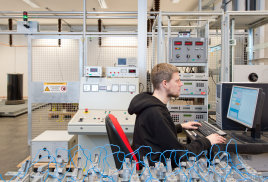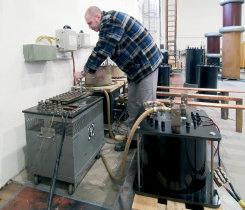High Voltage and High Current
Realization of the unit High Voltage and High Current
High currents (over 100 A) and high voltages (over 400 V) cannot be measured directly with electricity meters.

Therefore, electronic instrument transformers are applied to measure energy transported in power transmission lines: current transformers convert the high current to be measured (referred to as primary current) as accurately as possible into a secondary current (1 A or 5 A) that is easily measurable by electricity meters. Likewise voltage transformers convert the high voltage to be measured
(referred to as primary voltage) as accurately as possible into a smaller secondary voltage (e.g. 100 V).
Instrument transformers are electrical transformers especially constructed and designed to meet all the necessary accuracy requirements.
The test method for instrument transformers is based upon the comparison of the instrument transformer under test and a high-precision standard transformer. BEV uses voltage and current transformers which are regularly calibrated at the Physikalisch-Technische Bundesanstalt (Germany). The comparison is made with a current transformer bridge, whereby the device under test is charged with a burden similar to real operating conditions.
Additionally, calibrations of instrument transformer bridges and instrument transformer burdens are carried out at our laboratory.

Verification of Instrument Transformers
Electric instrument transformers are subject to verification in Austria. Only instruments approved by the BEV are acceptable for verification. Instrument transformers are verified by accredited verification bodies. Instrument transformers are exempt from reverification.